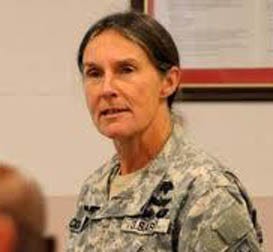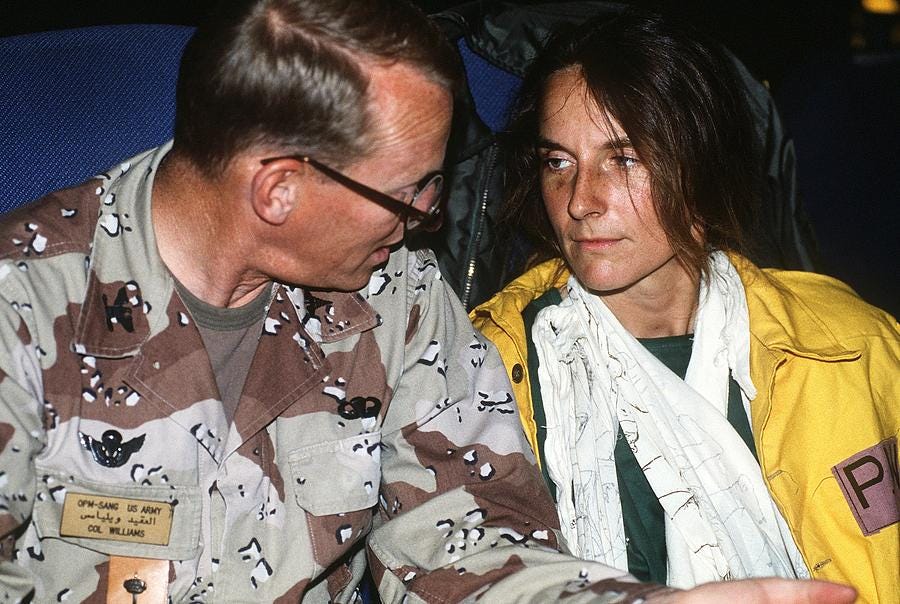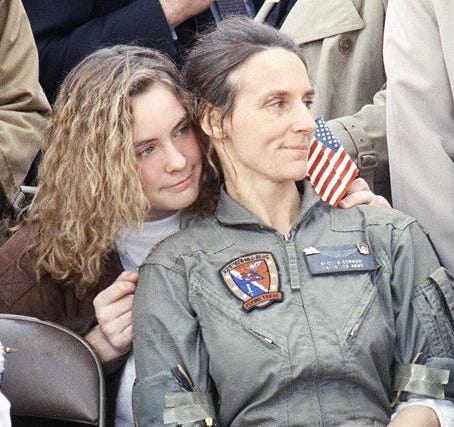What You Can Learn From a Woman POW About Grit and Resilience
Shannon H. Polson

Ifirst saw Dr. Rhonda Cornum speak at a Triangle Securities Conference in the North Carolina Research Triangle Park while I was still a cadet in 1993. I vividly recall a general officer at the conference expressing opposition to women serving in the Army, based on the assumption that women’s lives were more important than men’s beause of their capacity for childbearing. Dr. Cornum spoke evenly, challenging that assumption and its implications. She had a daughter. She was also an Army officer and flight surgeon. What danger she did or did not face was a decision that was hers to make.
I was awed by her strength.
Two years earlier, on February 27, 1991, Major Rhonda Cornum was in the back of a Blackhawk helicopter at refuel prepared for a passenger shuttle when the Blackhawk pilots got a call to change mission. An F-16 had been shot down, and the downed pilot was in radio contact but had a broken leg. The Blackhawk launched for the new mission. They flew fast and low across the desert, “so low that the pilot of our helicopter had to pull up to fly over the convoy of American trucks streaming through Iraq,” she writes in her book She Went to War. Fast and low is standard mission profile for an Army helicopter, easy prey to anti-aircraft fire.

Just 45 seconds after crossing over the American convoy, Cornum recalls green tracers streaking up from the ground “as if we were a lawn mower that had run over a beehive, and the bees were coming up to sting.” The soldiers on the door guns returned fire, and one of the shell casings from the machine gun hit Cornum in the face as she lay on the floor, anticipating another stray round to rip through the floor from below at any moment.
Then, “I felt something big hit the aircraft,” she writes. “The engine strained and the fuselage shook and shimmied.”
Cornum heard the pilot yell “We’re going in!” She remembers having time to grab on to the aircraft, and wondering if it was the end. Then everything went dark.
NOBODY’S EVER DIED FROM PAIN
The helicopter crashed at 140 knots onto the desert floor. Cornum remembers it was daytime when they crashed, and when she came to it was dark. She returned to consciousness and did not think she could move. In the distance, she saw a fire. Aware of the dangers of post-crash fires, she pushed aside the wreckage to find her way out of the mangled fuselage. She later remembers that her first thought was “Nobody’s ever died from pain.”

Cornum was a flight surgeon for the 229th Aviation Regiment, and held a PhD in biochemistry and nutrition from Cornell University. She had been recruited into the Army to work in a research facility in San Francisco.
“I was the least likely person,” Cornum says. “I really joined because I wanted to do research and I didn’t want to teach.” Once onboard, she realized she liked the Army.
“I liked the camaraderie, I liked the mission focus,” she tells Dr. Linda Tucker on the podcast Challenge Your Thinking.
She didn’t expect to deploy.
Initially, Cornum had hoped to join the astronaut training program. She had been a finalist, but was not selected. “I looked at that not as a failure,” Cornum says. “I realized it really probably wasn’t what I wanted to do.” This reframing of circumstance would be key to her success in getting through other challenges.
Instead she became a flight surgeon. When she deployed, her husband was also a flight surgeon in the Air Force, and she had a fourteen year-old daughter back in the states.
When Cornum pushed her way out of the wreckage of the Blackhawk, the noise of the engagement and crash had disappeared. It was silent, so quiet that she thought she was the only one alive. But her attempts at further movement were stymied by excruciating pain. She couldn’t stand up, or even turn over.
She made one more effort to stand, pushing through the blinding pain, and as she came to her feet, she looked up into the barrels of five Iraqi rifles.
Cornum noted the soldiers’ good uniforms and concluded that they were members of the Republican Guard.
One of the men reached down and grabbed Cornum by her right arm. A flash of severe pain ripped through her body and she screamed. She realized from the pain that her arm was broken. His tug dislocated it. From the angle her other arm was hanging in front of her, she could see it was broken, too. The man took her by the hair and dragged her after him.

Cornum was led into a well-fortified bunker deep in the earth for an interrogation. There she saw another of her crew members, a young pathfinder, who had also survived. Then both of them were pushed into a truck and taken to a second bunker, and then a third, each time interrogated by a new group of soldiers. Then they were put in another truck, and this time the guard in charge of Cornum sexually assaulted her. She remembers feeling as amazed as she was repulsed. Her hair was matted with blood over one eye, both arms broken, her knee badly injured.
Later she would recall that the most difficult part of her captivity was a mock interrogation, the feeling of the pistol against the back of her head, waiting for the click.
Cornum was rescued a week later. Then and now, she isn’t about to admit to problems with pushing through and past the experience.
CHANGE AND ADAPTATION
“I don’t do helpless at all,” says Cornum. “That was probably the most difficult thing, getting someone, especially the enemy, to help you.”

What did help her was changing her focus. Once captured, she decided that she had a new mission. That ability to change and adapt is something she identifies as critical for anyone going through challenging times.
“It’s all about plan B,” she says. Cornum says that she saw her job in captivity as keeping the prisoners alive. “You just have to have a mission change. Adaptability and flexibility are key.”
“I think trauma’s in your head,” says Cornum. “One of the most important things you can learn is that what you think and how you perceive events is totally up to you. The enemy may be able to tell you everything else… they cannot determine what you think. It’s your choice. I took that quite seriously.”
“What you can’t do is let it take over your life and you can’t ruminate about the bad part. I was grateful I was alive and I was grateful I was in the war that I was in. I felt very confident that I might be there for weeks, months, but I wasn’t going to be there for seven years.”
Cornum refuses to label her experience as trauma. “It’s an adversity…everyone has an adverse experience,” she says.
Cornum’s upbringing clearly contributed to the person she became today.
“My father told me you can do anything,” she says. “You can do anything but not everything. If you want to do something, you have to figure out how. You have to want to, but it’s up to you.” Cornum took that into her life with skydiving, steeplechase and shooting.
Adversity is just part of the process, as far as Cornum is concerned. “Women who run … have stronger bones than women who sit. It takes some adversity,” Cornum says. “I think it’s the same thing. There’s an optimal amount of disappointment and frustration and delayed gratification that you have to learn.”

After her talks, Cornum often hears her listeners say, “I could never have done that.”
She won’t have it.
“Fear limits the choices you see. The problem isn’t that they like being afraid or miserable, they don’t know how to get out of it.”
Now deeply involved in resilience work for the military, Cornum says that teaching the way to get beyond fear is a primary focus of her teaching.
“That was something we tried to teach in a comprehensive stepwise fashion (in the Comprehensive Soldier’s Fitness Program).”
At the same time, Cornum realizes that every challenge for every person is different.
“You can never judge someone else’s difficulty by your own stories,”Cornum says, “you can just use the same steps to get over it.”
FEAR NEVER HELPS YOU
When asked if she is afraid of anything, Cornum only reiterates that “fear never helps you.”
To combat fear, she suggests: “In your mind rehearse. Rehearsal (of all possible outcomes) is key…your feelings and your behavior are based on what you think and believe.”
“Resilient people have optimism in common,” Cornum says. “Resilient people believe a problem is specific and not global, that they are in a timeframe and not forever, and that there is something you can do about it.”

